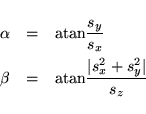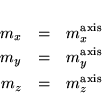



Next: Constraining the direction of
Up: Non-collinear calculations and spin
Previous: LNONCOLLINEAR tag
Contents
Supported only by VASP.4.5 and on. THIS FEATURE IS IN LATE BETA STAGE (BUGS ARE POSSIBLE).
LSORBIT = .TRUE. switches on spin-orbit coupling and automatically sets
LNONCOLLINEAR= .TRUE..
This option works only for PAW potentials and is not supported
by ultrasoft pseudopotentials.
If spin-orbit coupling is not included, the energy does not depend on the direction
of the magnetic moment, i.e. rotating all magnetic moments by the same
angle results in principle exactly in the same energy.
Hence there is no need to define the spin quantization axis, as long as
spin-orbit coupling is not included.
Spin-orbit coupling however couples
the spin to the crystal structure. Spin orbit coupling is switched on by selecting
LSORBIT = .TRUE.
SAXIS = s_x s_y s_z (quantisation axis for spin)
where the default for SAXIS= (the notation
(the notation  implies an infinitesimal small positive number
in
implies an infinitesimal small positive number
in  direction).
All magnetic moments are now given with respect to the axis
direction).
All magnetic moments are now given with respect to the axis  , where we have
adopted the convention that all magnetic moments and spinor-like quantities written or read by VASP are given
with respect to this axis. This includes the MAGMOM line in the INCAR file,
the total and local magnetizations in the OUTCAR and PROCAR file, the spinor-like
orbitals in the WAVECAR file, and the magnetization density in the CHGCAR file.
With respect to the cartesian lattice vectors
the components of the magnetization are (internally) given by
, where we have
adopted the convention that all magnetic moments and spinor-like quantities written or read by VASP are given
with respect to this axis. This includes the MAGMOM line in the INCAR file,
the total and local magnetizations in the OUTCAR and PROCAR file, the spinor-like
orbitals in the WAVECAR file, and the magnetization density in the CHGCAR file.
With respect to the cartesian lattice vectors
the components of the magnetization are (internally) given by
Where  is the externally visible magnetic moment.
Here,
is the externally visible magnetic moment.
Here,  is the angle between the SAXIS vector
is the angle between the SAXIS vector  and the cartesian vector
and the cartesian vector  ,
and
,
and  is the angle between the vector SAXIS and the cartesian vector
is the angle between the vector SAXIS and the cartesian vector  :
:
The inverse transformation is given by
It is easy to see that for the default
 , both angles are zero, i.e.
, both angles are zero, i.e.
 and
and  .
In this case, the internal representation is simply equivalent to the external representation:
.
In this case, the internal representation is simply equivalent to the external representation:
The second important case, is
 and
and
 . In this case
. In this case
Hence now the magnetic moment is parallel to the vector SAXIS.
Thus there are two ways to rotate the spins in an arbitrary direction, either
by changing the initial magnetic moments MAGMOM or by changing SAXIS.
To initialise calculations with the magnetic moment
parallel to a chosen vector  , it is therefore possible to either specify
(assuming a single atom in the cell)
, it is therefore possible to either specify
(assuming a single atom in the cell)
MAGMOM = x y z ! local magnetic moment in x,y,z
SAXIS = 0 0 1 ! quantisation axis parallel to z
or
MAGMOM = 0 0 total_magnetic_moment ! local magnetic moment parallel to SAXIS
SAXIS = x y z ! quantisation axis parallel to vector (x,y,z)
Both setups should in principle yield exactly the same energy, but for
implementation reasons the second method is usually more precise.
The second method also allows to read a preexisting WAVECAR file (from a collinear or
non collinear run), and to continue the calculation with a different spin orientation.
When a non collinear WAVECAR file is read, the spin is assumed to be parallel to
SAXIS (hence VASP will initially report a magnetic moment in the z-direction only).
The recommended procedure for the calculation of magnetic anisotropies is therefore
(please check the section on LMAXMIX 6.56):
- Start with a collinear calculation and calculate a WAVECAR and CHGCAR file.
- Add the tags
LSORBIT = .TRUE.
ICHARG = 11 ! non selfconsistent run, read CHGCAR
LMAXMIX = 4 ! for d elements increase LMAXMIX to 4, f: LMAXMIX = 6
! you need to set LMAXMIX already in the collinear calculation
SAXIS = x y z ! direction of the magnetic field
NBANDS = 2 * number of bands of collinear run
VASP reads in the WAVECAR and CHGCAR files, aligns the spin quantization axis
parallel to SAXIS, which implies that the magnetic field
is now parallel to SAXIS, and performs a non selfconsistent calculation.
By comparing the energies for different orientations
the magnetic anisotropy can be determined.
Please mind, that a completely selfconsistent calculation ( ICHARG= 1) is in
principle also possible with VASP, but this would allow the
the spinor wavefunctions to rotate from their initial orientation
parallel to SAXIS until the correct groundstate is
obtained, i.e. until the magnetic moment is parallel to the easy axis.
In practice this rotation will be slow, however, since reorientation of
the spin gains little energy. Therefore if the convergence criterion is not
too tight, sensible results might be obtained even for fully selfconsistent calculations
(in the few cases we have tried this worked beautifully).
- Be very careful with symmetry. We recommend to switch off symmetry ( ISYM=0) altogether,
when spin orbit coupling is selected. Often the k-point set changes from one to
the other spin orientation, worsening the transferability of the results
(also the WAVECAR file can not be reread properly if the number
of k-points changes). Additionally
VASP.4.6 (and all older versions) had a bug in the symmetrisation of
magnetic fields (fixed only VASP.4.6.23).
- Generally be extremely careful, when using spin orbit coupling: energy
differences are tiny, k-point convergence is tedious and slow, and the computer time
you require might be infinite. Additionally, this feature--
although long implemented in VASP-- is still in a late beta stage, as you might
deduce from the frequent updates. No promise, that your results will be useful!!!
Here a small summary from the README file:
- 20.11.2003: The present GGA routine breaks the symmetry slightly for non orthorhombic cells.
A spherical cutoff is now imposed on the gradients and all intermediate results
in reciprocal space.
This changes the GGA results slightly (usually by 0.1 meV per atom), but is important
for magnetic anisotropies.
- 05.12.2003: continue... Now VASP.4.6 defaults to the old behavior GGA_COMPAT = .TRUE.,
the new behavior can be obtained by setting GGA_COMPAT = .FALSE.
in the INCAR file.
- 12.08.2003: MAJOR BUG FIX in symmetry.F and paw.F:
for non-collinear calculations the symmetry routines did not work properly
- If you have read the previous lines, you will realize that it is recommended to set GGA_COMPAT = .FALSE.
for non collinear calculations in VASP.4.6, since this improves the numerical precision of GGA
calculations.




Next: Constraining the direction of
Up: Non-collinear calculations and spin
Previous: LNONCOLLINEAR tag
Contents
Georg Kresse
2009-04-23





![]() , it is therefore possible to either specify
(assuming a single atom in the cell)
, it is therefore possible to either specify
(assuming a single atom in the cell)